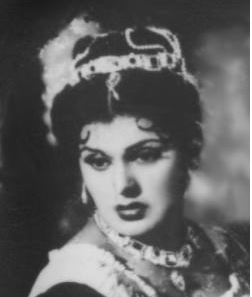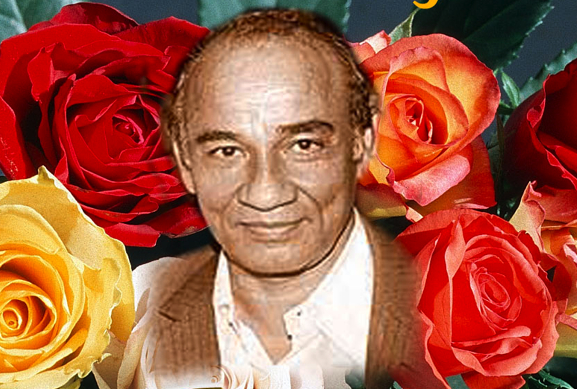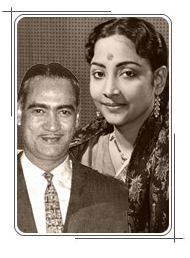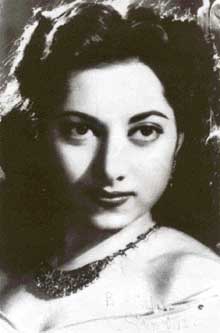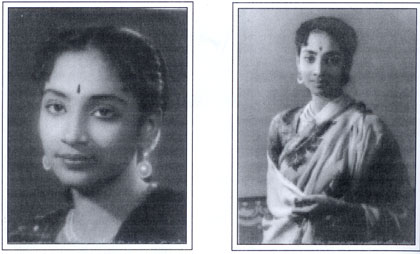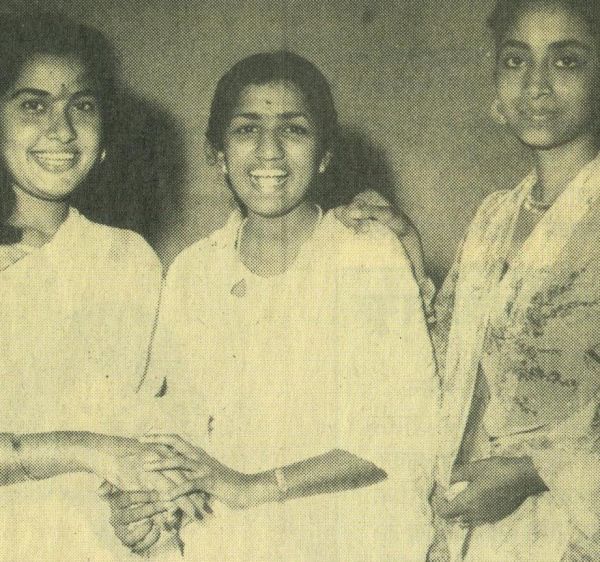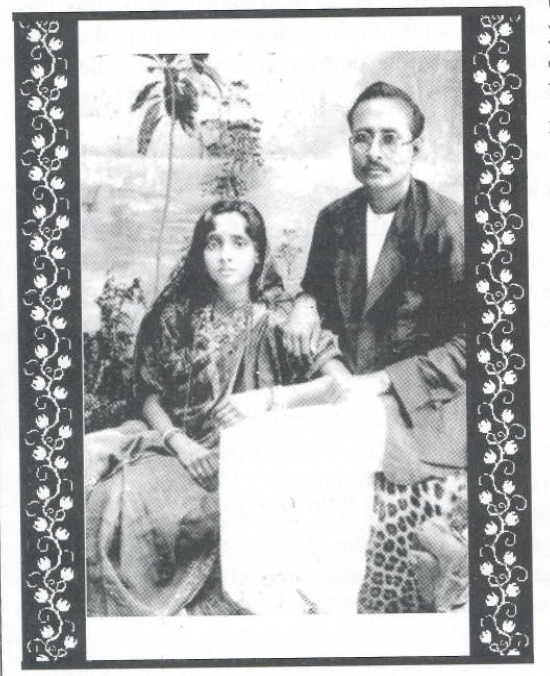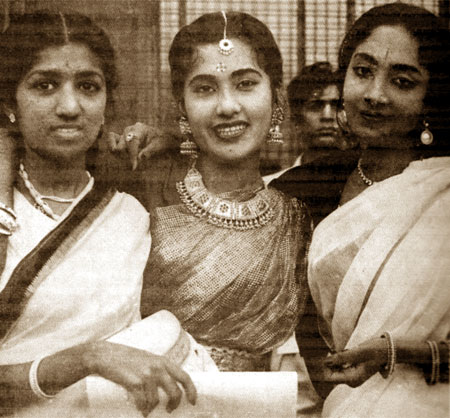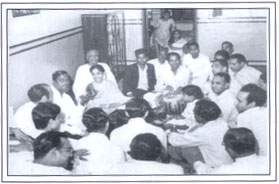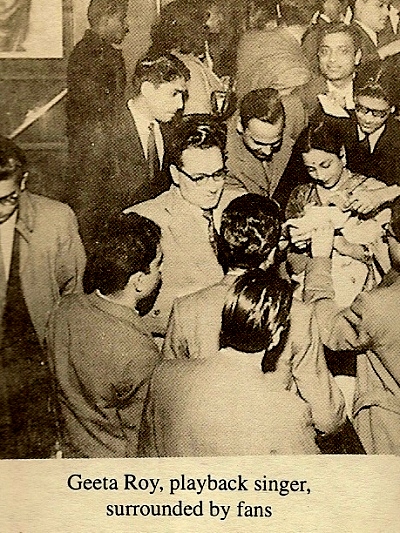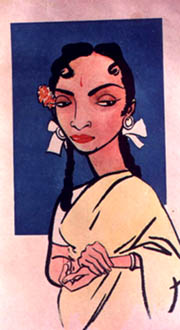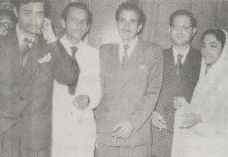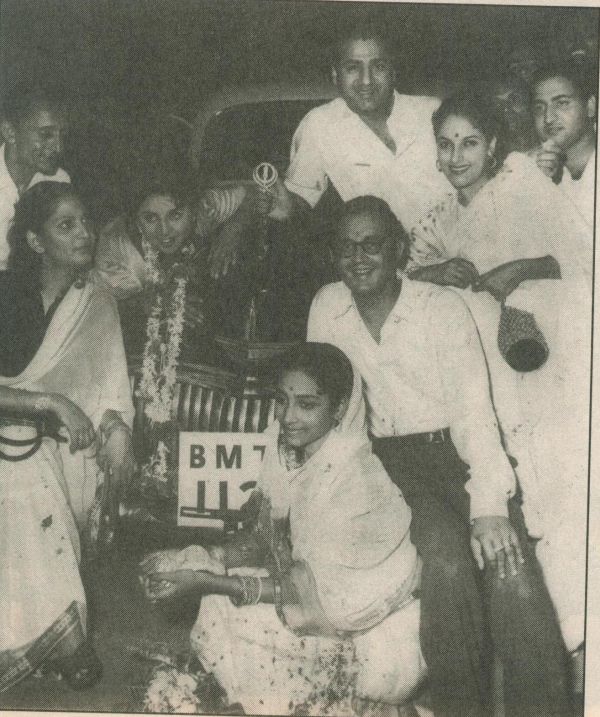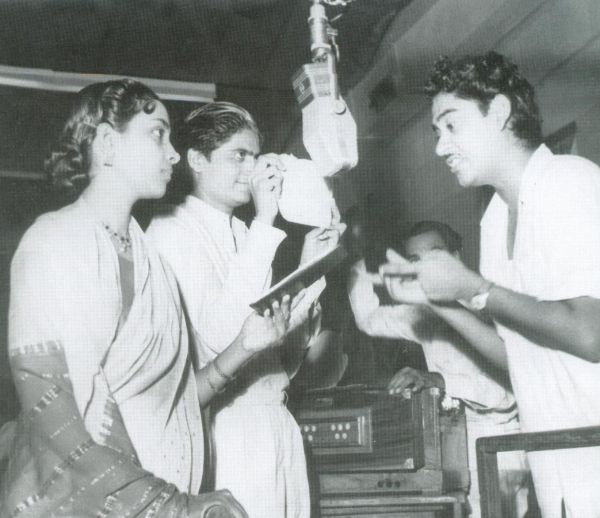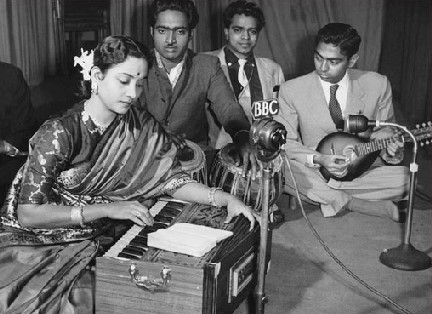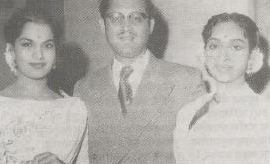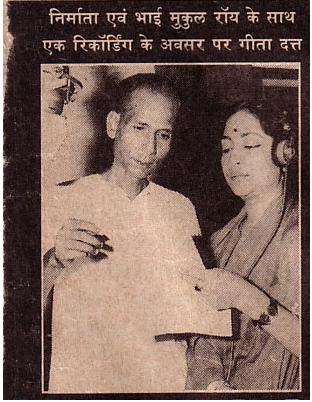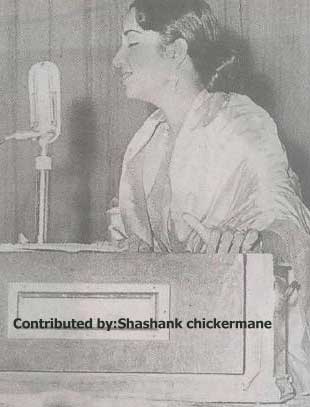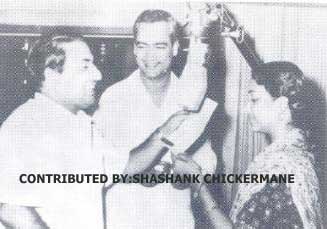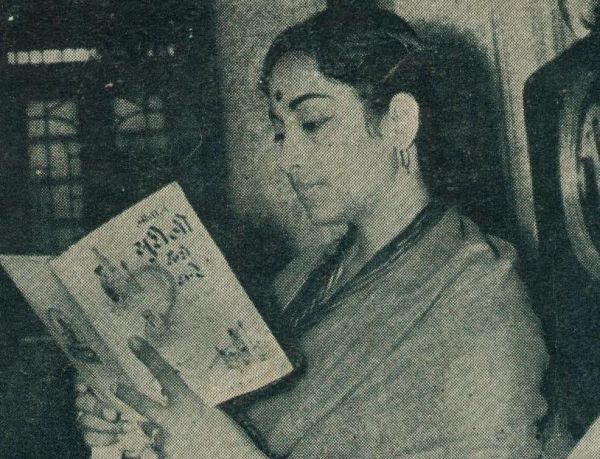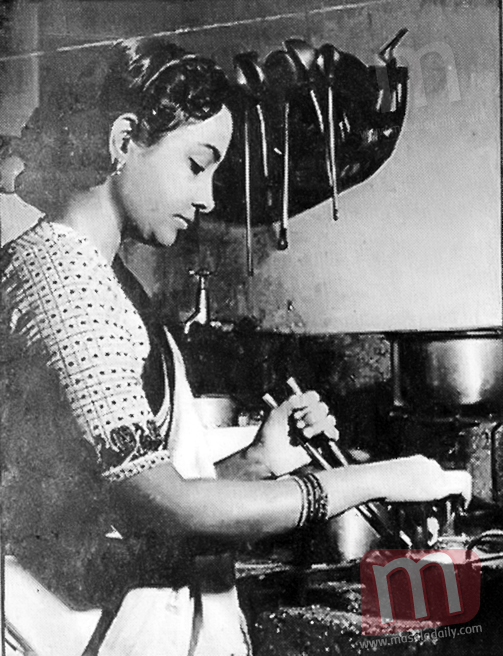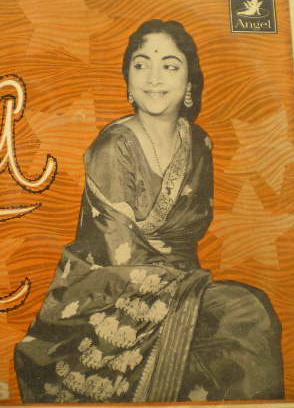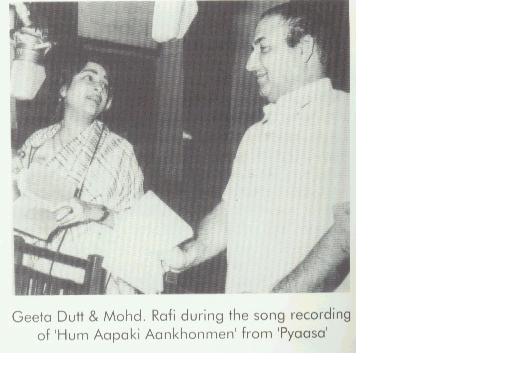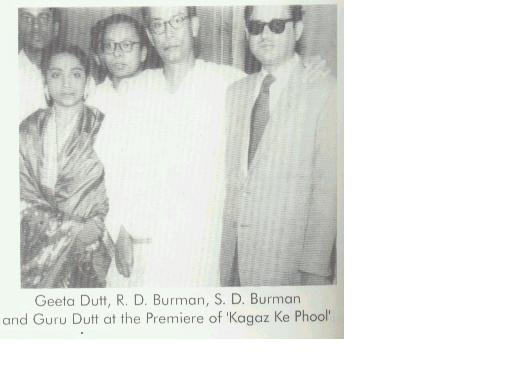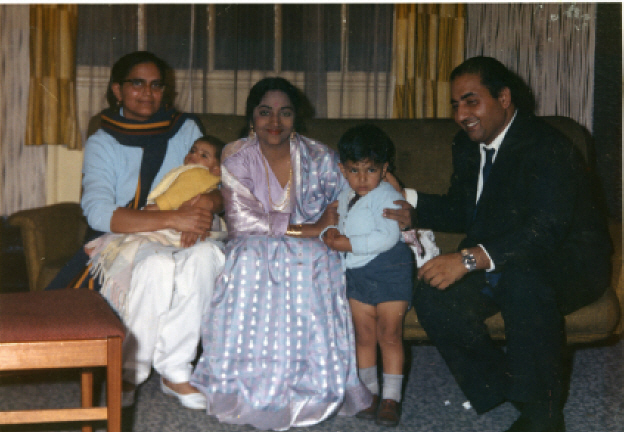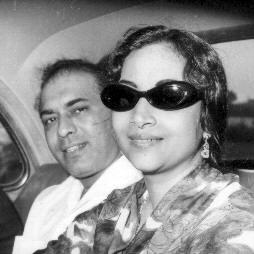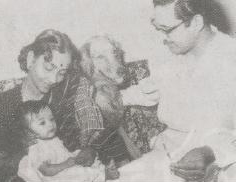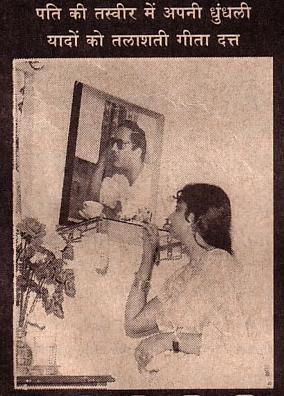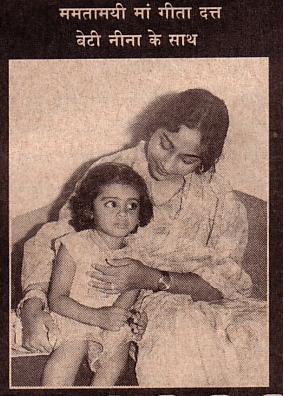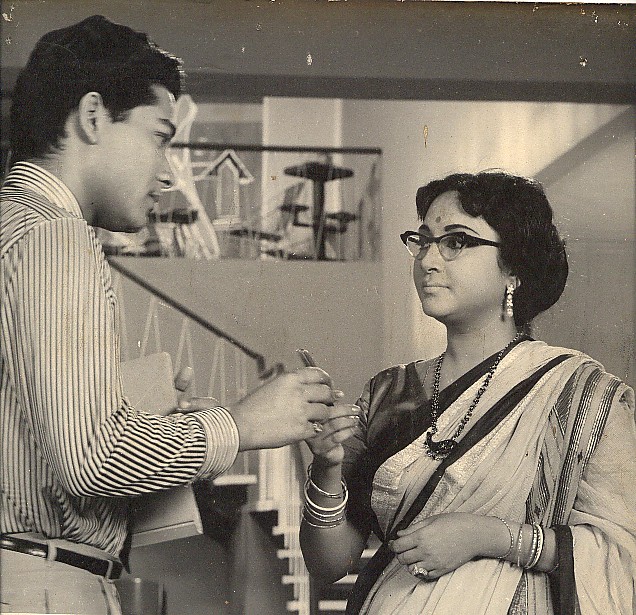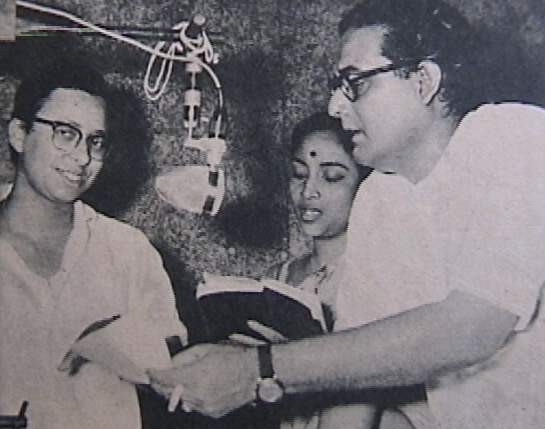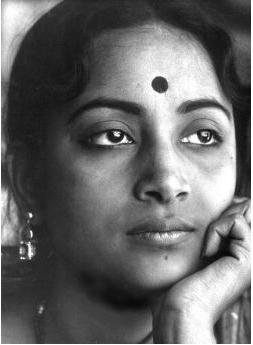
Geeta Dutt (nee Roy) was blessed with a rich voice that was like an interacting instrument that at once mesmerized her listeners. She had such magic in her voice that charmed her listeners like a snake is charmed to the music of a been. She rendered songs from her heart making them so endearingly heart rendering. When she sang “Thandi Hawaa Kaali Ghata” you can feel the cool breeze of an overcast day. When she sang “Koi Door Se Awaaz De” you can sense the feelings of a hauntingly disturbed soul celebrating the resplendence of life on one side and yet lamenting setbacks on the other. As critic Subhash K. Jha puts it aptly “Geta Dutt’s voice conveys the sweetness of honey and the pain of the bee sting.”
She sang over 1500 songs in her life in many languages like Hindi, Gujrati, Bengali, Marathi, Bhojpuri, Punjabi, Nepali etc. She sang with almost all the singers of the 40s, 50s and 60s and worked with over 100 composers. She is known as “Queen of Bhaav Gayaki” for her ability to fuse the right emotions in the songs she sang.
Early years:
Geeta Roy was born into a rich zamindaar’s family as Geeta Ghosh Roy Chowdhuri in Faridpur, East Bengal on 23rd November 1930. In 1942, her parents shifted to a Dadar apartment in Bombay when she was twelve. Over there in their modest flat at Dadar, composer Pandit Hanuman Prasad, overheard her singing and agreed to take her under his wings to provide her training with nuances of singing. Soon after this, he launched her in a chorus song in the movie “Bhakta Prahlad (1946)”, where she had only a couple of lines to sing. She sang as many as four songs for this mythological film. She sang them with the chorus but had some lines all by herself to her.
That singing of two lines in “Bhakt Prahlad” did a lot of good for Geetaji. She kept herself busy singing in several movies that year (1946). But her biggest breakthrough was yet to come and fortunately for Geetaji and music lovers it didn’t take long.
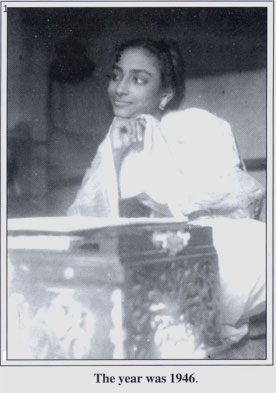
She was just sixteen at this time. But those two lines mesmerized everyone in the recording studio. In a matter of another year, in 1947, she got her break with “Do Bhai”. S.D. Burman heard Geeta ji’s voice and immediately decided to have her sing in “Do Bhai”. Geeta ji had this unconventional way of singing. The time was when most singing styles had origins of ghazals. Geeta ji who had this innate talent, with no formal training in singing of the type of songs that were in vogue at that time, introduced her own brand of appealingly fresh and free flowing style of singing. Her singing was based on instincts and spontaneity, guts and feelings, and love and pensiveness that resulted in breathing life and emotion into each song she sang.
The big break:
The music of the film Do Bhai (1947) was a major hit. In particular, her song “Mera Sundar Sapna Beet Gaya” became an overnight sensation. Her voice was so fresh, unique and ethereal it appeared to have breathed life into those songs. With the stardom achieved from the success of “Do Bhai”, Geetaji became extremely busy. Almost as if by magic, an obscure singer not known to many people across the country became a celebrity and a household word overnight. Even though she did not know any language other than her mother tongue Bengali, she was singing songs in fluent Hindi and even in Gujrati now.
With two great years in succession, Geetaji became the undisputed number one singer in the nation in 1949. She was virtually unchallenged at this juncture in her career. The hitherto established singers like Rajkumari and Shamshad Begum were relegated to lower spots. She sang memorable songs for Ranjit Movietone’s Jogan (1950) starring Nargis and Dilip Kumar. The music of this film was composed by Bulo C Rani for whom she sang several melodious songs in the 40s and 50s.
The fifties:
The year 1951 was a very eventful year in Geetaji’s life. When S.D. Burman had her sing songs of “Baazi”, sort of a complete metamorphism happened. With the thundering success of the songs and its music, the movie “Baazi” changed Geetaji’s life forever. Geeta Roy found herself extremely busy in 1952. She had assignment after assignment that kept her singing career in a high gear. She delivered hit after hit that year. Amidst all this, she found time to continue her romantic relationship with upcoming director Guru Dutt.
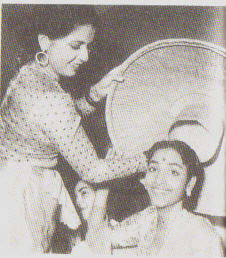
During the romance and early years of her marriage she sang some of her best songs for pictures involved with Guru Dutt in one capacity or another. Some of the most beautiful romantic songs Geeta ji sang were during these days and they were spilled and richly splashed with her youthfully exuberant voice. On one side she sings “Babu Ji Dheere Chalna” and the next moment she scolds her lover by singing “Jaa Jaa Bewafaa”. Next she entices her lover with the song “Hoon Abhi Main Jawaan”. When he is crossed with her she begs by singing “Yeh Lo Main Haari Piya”. This whole gamut of romantic spectrum emotional rainbow was never repeated with such vibrant verve of vocals and velvety velocity of spells of splendor by anyone else before or after Geeta Ji.
Clearly early fifties were her best years as a playback singer supreme. During these years, she still maintained the status as an influential vocalist of Hindi film world because she kept singing song after song delighting millions of moviegoers throughout India. The young and famous Geeta Roy and the struggling director Guru Dutt tied knots on May 26, 1953. Because of the wedding and the new responsibilities of a new household Geetaji found herself with not much time to sing in as many songs this year as before.
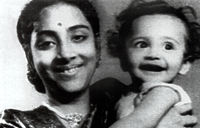
Being wed for two years and raising a son who already was a year old, Geetaji found little more time in the year 1955 to participate in singing. Her husband Guru Dutt made “Mr. and Mrs. ‘55” during 1955. It had Madhubala and Guru Dutt in the leads and was directed by Guru Dutt himself. Its music once again was composed by O.P. Nayyar. By this time, the Geetaji-OP tandem were in sync as the pair delivered hit after hit. “Mr. & Mrs. ‘55” was no different. This had nine songs and Geetaji sang six of them.
Year 1956 was another eventful year in Geetaji’s life. She gave birth to her second son, Arun, on July 10. With her first son growing up, with the arrival of newly born, and her husband Guru Dutt busy with the production of “C.I.D.” and laying groundwork for his groundbreaking “Pyaasa”, she still managed to find time to sing. In “Toofan Aur Diya” released in 1956, she sang three songs for Vasant Desai (two solos and a duet). One of the outstanding song from this was the solo Geetaji sang “Meri Aan Bhagwan”. She continued to sing for almost all the major composers of that era. In her career spanning 26 years, she sang for more than 100 composers.
Geetaji was back singing for Burmanda in two movies in 1957. These were “Nau Do Gyarah” (two solos and a duet) and “Pyaasa” (three solos and a duet). Guru Dutt’s “Pyaasa” was a landmark in Indian movie history. It was voted as one of the top 100 movies in the world by the Time magazine. In spite of many personal problems she was having, Geetaji, a phenomenon she was, still found time to keep her singing career intact as late as 1958 and 1959. Singing was her love. She wasn’t going to give it up without a fight. In her husband’s “Kaagaz Ke Phool” Geetaji sang the song of her life. “Waqt Ne Kiya Kya Haseen Sitam”.

The troublesome sixties:
Her marital problems were taking a heavy toll on Geetaji by the early sixties. It appeared on the surface that this may slow down her singing assignments, but she still managed to sing in the movies. In 1961, in spite of all the problems they were having Geetaji and her husband, Guru Dutt, were still living together. There was still something left between the two. These brief moments of harmony were giving her enough strength to continue with her passion, singing.
Year 1962 was another eventful year in Geetaji’s life. The proof that there was love still existed between Geetaji and Guru Dutt, their third child, a daughter named Nina, was born in August. This however did not solve their problems. The impending gloom and doom was fast nearing. The decadence was now completely set in by 1963. Geetaji’s fortunes were on the fast decline. She was withdrawing herself from everything. She got separated from her husband. The year 1964 was a devastatingly eventful year in Geetaji’s life. On October 10, Guru Dutt died of an overdose of sleeping pills. He was only 37.
By early 1965 Geetaji recovered from the mental breakdown she suffered after her husband’s unexpected death. Shattered and devastated, she was slowly trying put her life together again. There is so little activity went on for Geetaji during the years of 1966 to 1969. It is so hard to believe that a great talent like Geetaji, who ruled the world of singing, who mesmerized music loving people all over India, went into obscurity and oblivion during these last years of her singing.
The last flicker of the lamp:
In 1970 Geetaji sang in only one movie, a solo in Ratandeep Hemraj’s “Insaan Aur Insaan” . Geetaji sang in three movies in 1971. These were Kanu Roy’s “Anubhav” (three solos), a duet in Salil Chowdhury’s “Raat Ki Uljhan”, and a triplet in Shankar – Jaikishan’s “Jwala” .
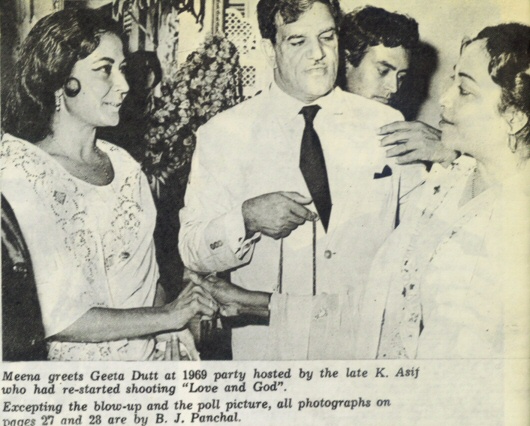
A note about the songs of “Anubhav”. Geetaji sang these so beautifully with plenty of melody that surprised even her worst critics. She once again proved to the music world that she still has it in her. Everybody thought she will now bounce back because they represented some of her finest work. But life takes many unexpected and tyrannical turns. It is so hard to believe that these songs would also be almost her swan songs. Talking about melody, take for example, the song “Koi Chhup Ke Se Aake” from “Anubhav”. Here is one music lover wrote about this song (the quote is not exact but is reworded). “… The soft, romantic type of songs like these flowered in Geetaji’s melodious and expressive voice… Geetaji’s singing in “Anubhav” demonstrates how much she still had to offer even at the fag end of her life. In this song, she is soft, teasing, whimsical, romantic all at once and the ever so slight tinge of pathos in her voice highlights the enigma that was Geeta Dutt…”.
The tragic end:
1972 was an eventful year in Geetaji’s life and in the history of Hindi film world. She sang in only one movie that year, Subir Sen’s “Midnight”. These were a solo and a duet. But on July 20, 1972, Geetaji passed away as a result of continuing and declining bad health. She was just 41. The voice that thrilled and filled with joy for millions of music lovers was gone forever. Here she was whose voice stopped aging as proven from the songs of “Anubhav”, sang only the previous year, finally succumbed to ill health. The voice that had the youthful joie de vivre was completely quelled. The ease and spontaneity that were the hallmarks of Geetaji’s singing could never sing another song. The voice that defied convention with its enthralling tonal quality, that was sumptuous in expression, that was enticing with melody, that was sweet like honey, that had soothing mellifluous quality, that was enchantingly dulcet, and that explored a gamut of emotions from subtle enticement to wistful longing was extinguished forever.
Geeta ji in a short and glorious span of only few years left us with a rich legacy of thousands of songs into which she breathed life with her unique ethereal voice that have stood the test of time and continue to enthrall generations after generations of fine music lovers all over the world.
A small tribute to the legend:
Please visit our website dedicated to this legendary playback singer to know more about her life and her singing. You can also listen to her songs and see videos of her songs as well.
Note:
Many thanks to our friend “Swarpriya” ji for the help for this post.
This post first appeared on Passion for Cinema blogpage here.
